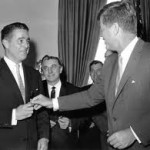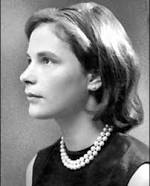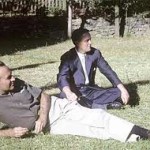New Kennedy Book Gives Short Shrift To The Peace Corps
Being published this coming October is Camelot’s Court: Inside the Kennedy White House by historian Robert Dallek, author of the previous Kennedy book, An Unfinished Life: John F. Kennedy, 1917-1963 and Nixon and Kissinger, a finalist for the Pulitzer Prize, among other books. This new book offers, according to the press release, “a penetrating look at the inner circle or brain trust that defined the Kennedy administration.”
As we know, the Peace Corps in 1960 was Kennedy’s experiment in international development that others called a wacky and dangerous idea. The Daughters of the American Revolution warned of a “yearly drain” of “brains and brawn…for the benefit of backward, underdeveloped countries.” Former President Eisenhower declared it a “juvenile experiment,” and Richard Nixon said it was another form of “draft evasion.”
Not everyone among Kennedy’s ‘best and the brightest’ were keen on the Peace Corps idea. Kennedy’s staff had been thinking of a small, low-cost addendum to the overall foreign assistance program, as Ted Sorensen, the President’s special counsel, told Shriver. Shriver had in mind a “large, independent new government agency which could be in the field within a few months.” Another staff against Shriver’s idea of an independent agency was Ralph Dungan, who Kennedy had made head of a task force to overseas assistance programs.
But Shriver, with the help of the Vice President and the hard work of Bill Moyers, got his way. The following year, Time magazine declared in a cover story that the Peace Corps was “the greatest single success the Kennedy administration had produced.”
In Dallek’s book of nearly 500 pages, the Peace Corps gets a page, mostly about picking Shriver to be the first director, and saying that Kennedy viewed the agency as making a difference not only in helping the less advantaged but also in advancing the national interest. (Dallek actually gives more attention to Mimi Beardsley Alford, the nineteen-year-old intern who had an eighteen month affair with Kennedy in the summer of ’62.)

Mimi Alford
Dallek writes, “Kennedy hoped the Peace Corps could become a model for how his administration would perform: a collaborative effort of the best minds and most well intentioned to create an innovation program serving both the world and the nation. By 1963, within two years of its founding, the Corps had enrolled 7,300 volunteers serving in forty-four countries.”
That’s it for the Peace Corps. The author moves onto The Alliance for Progress and then Cuba. In reviewing an advance, uncorrected proof of the book, I can’t find another mention of Shriver or the Peace Corps.
Interestingly, Harris Wofford, who with Shriver, lead the Mayflower Hotel Gang in setting up the agency in the winter months of 1961, gets more print from Dallek as the author writes about Kennedy and civil rights.
Dallek writes that Kennedy, as he prepared to launch his administration, was assigned some aides to develop a civil rights agenda. “The key figure in assembling personnel and a program for the fight ahead was Harris Wofford.” Dallek mentions how Wofford had persuaded Kennedy to call Coretta Scott King and help arrange the release of her husband from the Reidsville, Georgia state prison, where he had been sent for having an expired driver’s license, and details over several pages all of the other early civil rights steps taken by Kennedy, but he mentions only Wofford’s involvement with the framing of the new Peace Corps in passing when a small group of university presidents quizzed Kennedy about who was going to be appointed special assistant on civil rights. Kennedy said Wofford and the academics replied that he (Wofford) was working on establishing the Peace Corps.
Kennedy replied, “that’s only temporary.”
Kennedy moved slowly on civil rights in ’61 and by March of ’62, Wofford wrote Kennedy that he wanted to go full time with the Peace Corps and by August of ’62 Wofford was on a plane with his family to Ethiopia as the first Peace Corps Director to Ethiopia, and as the Peace Corps’ Special Representative in Africa. Wofford would spend the next five years with the agency, returning to Washington in the summer of ’64 to become an Associate Director. So much for a temporary job at the Peace Corps.

Wofford and Shriver in Addis Ababa
In 1966 Wofford would leave the agency to become the first president of the new State University of New York Old Westbury College on Long Island, but, as we know, he is still linked to the Peace Corps in many ways and through many connections.
My guess is that Dallek, as a historican and not a journalist, did a lot of reading, and not much interviewing of the members of the Kennedy Court, in writing this book. Well, in due course, with the publications of all the memoirs and histories now being written by RPCVs, our days in the sunlight will come, and we will tell the world the real story of the Peace Corps, which is, as we all well know, what PCVs have been doing on their own since the fall of ’61.
Thanks for pointing out the scant attention Dallek gives the Peace Corps, John.
Unfortunately I suspect the NYT Book Review section and the Washington Post will look to others for critiques of Dallek’s study on JFK’s inner circle.
Still, once a review comes out in a national daily, maybe you could write a cogent letter about the short shrift Dallek gives to Shriver and the Peace Corps.
Kennedy, Shriver…Lightning does the work and thunder gets the credit.
In his first book on JFK (John F. Kennedy: an unfinished life 1917 – 1963) Robert Dallek concludes that “The Peace Corps proved to be one of the enduring legacies of Kennedy’s Presidency (p.340).” He also notes that the Peace Corps and JFK’s commitment to the land a man on the moon “were great successes (p.709).”
I met with Dallek in Boston and Washington. I believe that the quotes above accurately reflect his personal and professional perspective on the importance of the Peace Corps.
RONALD, Thanks for citing Dallek’s prior JFK book to clarify Dallek’s positive views of the Peace Corps.
JOHN, Of course, not everyone who reads Dallek’s newest book will know what Ronald just explained. So a letter from Peace Corps Worldwide’s editor (i.e., you) to an editor of a big national daily remains in order. We need to capitalize on every opportunity to keep the Peace Corps on everyone’s consciousness radar.
I agree.
I also think the Peace Corps would be seen as closer to Kennedy if it made its mission of Peace the top priority for PCVs. Peace with a minor in development, education, or health…Peace, No. 1. Maybe there should be a shoulder/backpack embroidered patch, ‘Peace Corps’.